How to carry a 1911 concealed.
The 1911 is a not a small gun but it is possible to conceal a full size 1911 comfortably. There are a few different options to carry this gun and I will explain these methods and offer some insight from my 15 plus years of carrying a concealed 1911 pistol. I will also discuss 1911 Appendix carry further down in this article.
There are basically three sizes of 1911s available.
- Government model, originally known as the M1911 pistol which has a 5-inch barrel.
- Commander model, which typically has a 4.25-inch barrel
- Officers model, with a 3 1/2 inch barrel.
Different manufacturers may refer to these with different names. For example, Kimber uses the term “Custom” for their 5″ barrel models, “Pro” for the smaller Commander sized guns with 4″ barrels and “Ultra” for the smallest 3″ barrel models.
Check out these books on the 1911. How to disassemble, clean and maintain 1911 pistols.
All three sizes can be concealed and obviously the smallest is easier to do so. I personally own a 5″ Government model but normally carry a Commander size 1911. The picture shows my usual method of concealment (uncovered so you can see my set-up). The holster shown is a Crossbreed Supertuck. Crossbreed carries some other excellent 1911 holsters, including their new Reckoning Holster that is perfect for Appendix Carry as well as OWB and IWB.
See the Reckoning holster on Crossbreed’s website here.
Why do I carry a 1911?
I have several firearms that I could carry, but most of the time I carry my Kimber Pro Carry II 1911. I also recognize that it holds only 9 rounds (8 in the magazine and 1 in the chamber) so I always carry at least one extra magazine, for a total of 17 rounds on my person. Beside the fact that I love the look and design of the 1911, I have several other reasons for choosing this gun for my everyday carry.
My reasons for carrying a 1911
- It is a full size gun. Full size guns are easier to shoot, easier to aim and tend to be more accurate.
- I have trained with my 1911. I have a lot of experience and training with the 1911. I believe it is incredibly important to carry a gun that I am comfortable with and have a lot of muscle memory in drawing, shooting and malfunction clearing. If I decide to carry a different pistol, I would need to train extensively with it before I would be confident carrying it for my family’s protection. I have reviewed Front Sight Firearms Training Institute if you are interested in professional defensive handgun training.
- It is accurate. My Kimber 1911 is an extremely accurate pistol. Although accuracy is 99% determined by the skills of the shooter, having an accurate gun certainly doesn’t hurt!
- It is reliable. As long as I keep my 1911 clean, tested and lubed correctly, I trust it to perform when I need it. See How to Clean a 1911. Is it as reliable as a Glock? From what I have read and heard, probably not. I do not own a Glock but I have read plenty about their reliability and I do not dispute that it will probably still shoot if dropped from a plane and covered with mud. However, I do not plan on these things happening to my 1911, so I am good.
- It shoots .45 ACP. 9mm is great, but .45 is better. This is my opinion, but if you disagree, let me know in the comment section below!
- I like the way it feels in my hand. Everyone is different, and the 1911 fells like it fits my hand like a glove. My hands are average size.
My main carry gun is a Kimber Pro Carry II, which has a 4.25-inch barrel and is a Commander size gun. I have been carrying this firearm concealed for 15 years on a daily basis and I’ve never had a problem. The Kimber Pro Carry II 1911 has an aluminum frame which makes it a bit lighter than a steel frame. This helps with comfort over a long day.
I have recently purchased a Kimber Aegis Elite Custom which has a 5-inch barrel and has a steel frame. As you can imagine, it is a bit heavier and larger, but I can still carry it in a Crossbreed Supertuck holster with excellent concealment.
1911 Concealed Carry Gear
There are 2 things you MUST have in order to safely and comfortably carry a 1911:
- A high quality holster
- A high quality gun belt
I wasted a lot of time and money trying to find a cheap holster, and I wore it on my regular everyday belt. Save yourself some time and hassle and get yourself a really good holster and you really need to wear in on a sturdy belt that is designed to carry a gun.
The belt needs to be stiff and strong so that it does not twist or sag as you go about your day. You will constantly be repositioning and fiddling with your gun and holster if you do not use the correct type of belt. Here is a great option:
1911 Concealed Carry Methods
Here are some great options:
- 1911 appendix carry
- IWB just behind the firing side hip.
- IWB at the small of the back
- OWB (Outside the Waistband) on the firing side hip.
I will go into detail on each method and offer my thoughts and experience.
1911 Appendix carry
Appendix carry of a full size 5″ 1911 is certainly possible but I would recommend using a commander or officer size pistol which both have shorter barrels.
A gun belt with a small buckle is important when using an Appendix holster. If the buckle is large, it will stick out through your shirt and possibly draw attention. The belt I am wearing is relatively inexpensive and has a minimal buckle, but is still super strong and secure. You can check it out here.
Appendix carry is carrying the gun inside the waistband in the front of the body approximately where the appendix is located.
Important: Appendix Carry with any handgun requires extensive training and a thorough knowledge of safety and drawing and re-holstering your weapon. This is because in most cases, and especially while seated, your firearm is pointed directly at your femoral artery.
If you follow the 4 rules of firearms safety, especially rule number 2 which is to keep your finger off the trigger until you are ready to shoot, you will be completely safe.
One potential problem with appendix carry is when you sit down or drive a car. If the holster and the gun are not optimally situated, the barrel of the gun can poke painfully into your groin and or upper thigh. This is not only uncomfortable but is potentially very dangerous if the gun would happen to fire while drawing or holstering the weapon. I am currently experimenting with a high-quality appendix holster and my Kimber Pro Carry II with a 4.25 inch barrel 1911.
1911 Appendix Carry Holster Video
The holster in the video is a Tier1 Axis Slim. Visit the website.
The magazines I use in my 1911 are Wilson Combat or Chip McCormick and hold 8 rounds. My total round count is 17. There are 8 in each magazine a one in the chamber.
Here is a link to Brownells 1911 magazine page. This is where I buy all my magazines.
Here is a less expensive appendix rig for a 1911:
The tactical pants I am wearing are Truspec 24/7 lightweight tactical pants. See my Tactical Pants review.
Appendix Carry Belt video:
Here is a video about my preferred Appendix Carry Belt
I am currently switching to appendix carry myself for several reasons. My old method was on my belt in the 4-5 o’clock position. Here is why I am switching:
- Printing. I am always concerned that when I bend over, the gun will print, especially when wearing a T-shirt.
- Better control. I feel I can “protect” the gun better in the front, and it cannot be easily taken from me.
- Quicker draw. There is no faster draw than from the appendix position. It takes practice, of course, but it is fast.
- Flexibility issues. As I get older, it gets harder for me to reach back to draw my weapon. Appendix solves this problem.
- Easier to draw in a vehicle or sitting down. This is big. It was extremely difficult to draw my 1911 from behind my hip while I am basically sitting on it.
Update: After appendix carrying for a few weeks now, I have some additional information. First, it definitely takes some time to get used to it. There is some poking going on especially when sitting in the car. I recommend removing the holster before getting into the car and don it after getting out if the location is appropriate. This will prevent some discomfort.
The second thing is something I ran into as soon as I started practicing my draw from the Tier1 holster. I am a pretty hairy guy, and every time I drew the gun, I also ripped out a few hairs that got pinched between the gun and my thumb. I fixed this problem by purchasing a $20 MicroTouch Solo and shaved my entire torso! Well, not really, shaved, but trimmed to about 3 mm. This fixed the issue immediately.
IWB just behind the firing side hip.
This is the method that I have used for 15+ years and I’m very comfortable with this method. I have used the same Crossbreed Super Tuck holster for all those years and it is still in excellent condition although it looks a little worn.
This method of 1911 concealed carry works very well in most situations, and once you get used to it can be quite comfortable. Be sure that you practice your draw to make sure that you can reach back comfortably and quickly. I recommend practicing drawing from this position weekly with an unloaded gun to make sure you will be able to do it if and when the time comes.
If you are squeamish about the position of the muzzle with appendix carry, then I would highly recommend this option.
Be sure that you have a belt that is designed to carry a firearm, and a very good holster such as a Crossbreed Super Tuck. There are other fine holsters that are similar, although I cannot vouch for them as I have not tested them.
IWB at the small of the back.
This is basically the same as the prior method, but with the gun all the way behind you at your back. I do not recommend this option due to the difficulty in drawing the firearm. It can also be extremely uncomfortable, although depending on your specific anatomy, it may work for you. I have tried it but it did not go well!
OWB (Outside the Waistband) on the firing side hip.
This is the best location to have your gun IF you can conceal it.
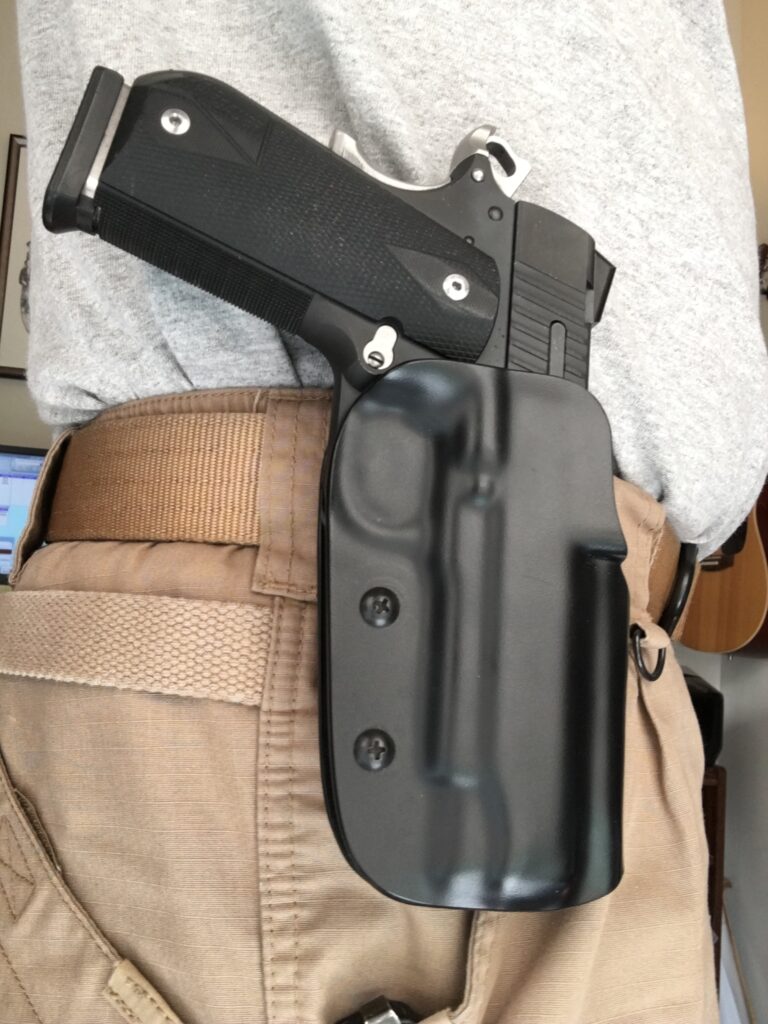
If you are someone that always wears a suit jacket or a heavy un-tucked shirt or some other kind of heavier clothing then this may be the best option for you.
This is obviously the best location for open carry, but we are not talking about that in this article. Most of the professional training I have taken recommends this location for training purposes. In the training setting we did wear some kind of an outer garment in order to practice drawing from concealment. However, in every day life this method of carry isn’t always appropriate especially in a warmer environment.
One of the big advantages to this method is that you will have easy access to the weapon in almost any position. you can get to it standing, sitting, kneeling and even prone. It is also close to your firing hand at all times.
If I am going to be outside for a while in cooler weather, I will consider using this method. I use a Blade Tech Signature holster for this purpose. My Blade Tech, like my Super Tuck, has served me well for 15 plus years and comes highly recommended.
Here are some other methods of 1911 concealed carry that I will not get into for this article. They are less popular but worth mentioning;
- Shoulder Holster
- Holster Shirt
- Cross Draw Holster
I have used several methods for carrying my 1911. Ultimately for the past 15 years, as mentioned above, I opted for IWB (Inside the Waistband) carry at the 4-5 o’clock position. This simply means I carry on my belt just behind my right hip. The key, of course, is to find a carry method and a holster that makes carrying this 1911 as comfortable as possible so that it becomes part of your every day habit. It will be a little while before appendix carry becomes second nature.
Condition of the 1911 when carrying concealed.
The 1911 is designed to be carried in the “cocked and locked” condition, which means there is a round in the chamber, the hammer is back (cocked) and the thumb safety is on (locked). This method of carry seems to concern a lot of people as it seems unsafe with the hammer back. However, the 1911 has mechanisms to help ensure it will not fire by accident.
There are two other ways that 1911 can be carried.
- Empty chamber with the hammer cocked. This method would require the slide to be racked to load a round before the gun can be fired. This is not recommended for concealed carry as this takes precious time to perform and you may not have both hands available in the instant that you need to defend your life.
- Round in the chamber and the hammer down. In this case, in order to fire the gun one would simply have to cock the hammer and would be able to fire. This is not a very common option. In order to get the gun into this condition, it would require you to lower the hammer on a live round and if you are not careful in doing so you could experience a negligent discharge.
1911 Safety System
The modern 1911 has 3 safeties that help prevent accidental or negligent discharge:
- Thumb safety. This is the manually operated safety lever on the side of the slide. This safety must be released by the shooter for the gun to fire.
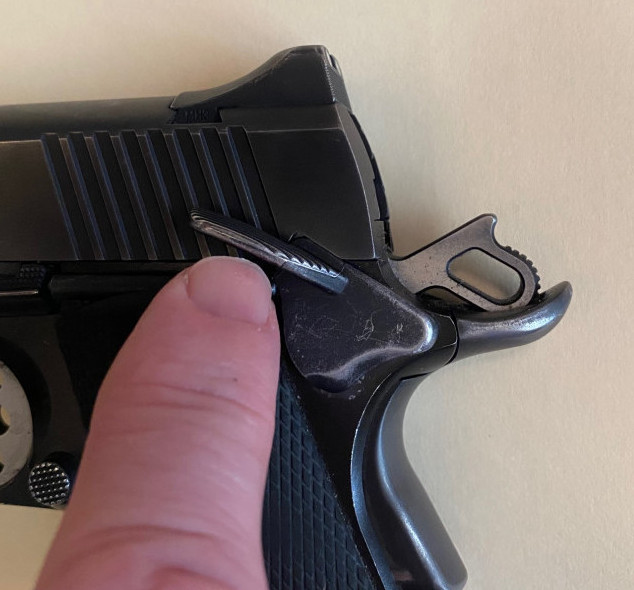
- Grip safety. This is a lever on the back of the grip (stock) that must be depressed to allow the gun to fire. A proper grip on the gun will automatically defeat this safety.
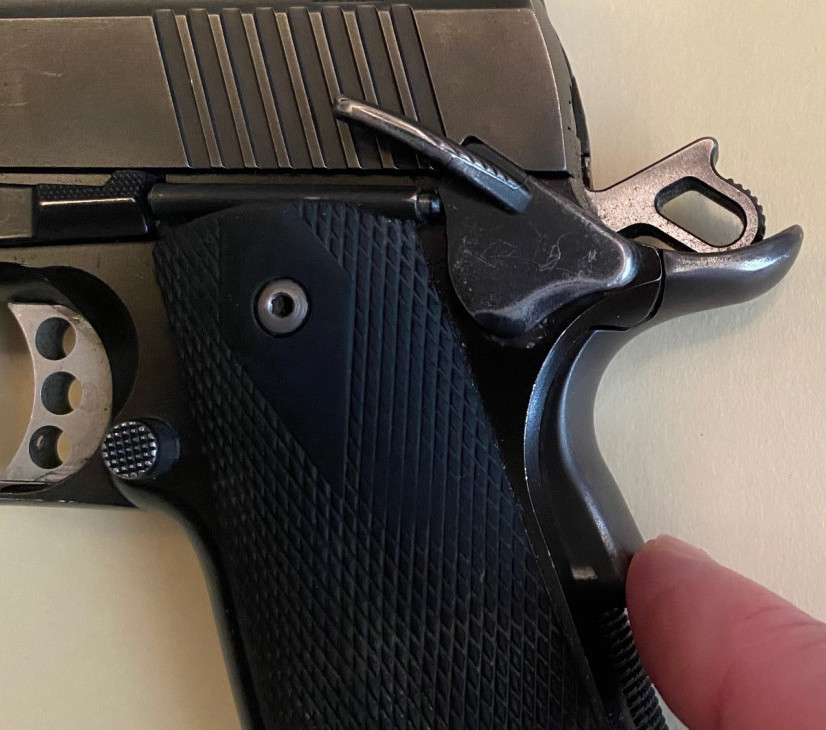
- Firing Pin Block. This is an internal mechanism that prevents the firing pin from striking the cartridge when the gun is dropped. This internal safety is only defeated when the trigger is pressed. Older 1911’s could go off when dropped until this safety was integrated into the pistol.
- Proper Holster. This is the most important safety. You must use a quality holster that is made for a 1911. I consider this a “safety” because when the gun is properly holstered, it must not be able to fire. This means the holster must completely cover the trigger and trigger guard, and must be made of a material that prevents fingers or foreign objects from getting to the trigger through the material (I am talking to you, cheap nylon holster). Also, the holster must prevent the gun from falling out if you bend over, fall down or participate in activities that involve some running or jumping.
Because the standard 1911 uses a single stack magazine, the gun is really not very wide. I have a 9 mm Springfield XDm that is wider in the handle than my 1911 pistol.
Also, believe it or not, my Springfield XDm is larger than my 1911, and when fully loaded, weighs about the same!
My main method of daily carry is on my right hip in the 4-5 o’clock position in a Crossbreed Supertuck inside the waistband holster. I have had this same holster for about 15 years.
The problem with carrying a 1911
I believe the only issue with a 1911 is round capacity. I have certainly heard and considered the arguments about capacity and that carrying a gun that has a larger magazine capacity is better. I agree with that to a point. My Springfield XDm has a magazine capacity of 19+1! (Although it is recommended to load the magazine a round or two below capacity to avoid wearing out the magazine spring prematurely) If I carried my XDm fully loaded with a spare mag, I would have 39 rounds on my person, compared to 17 with my 1911.
I have wavered back and forth on this issue and almost decided to start carrying my 9mm XDm. If I were a police officer or someone that is more likely to get into a gun fight, I think I would definitely opt for the higher round capacity. Since I am just a mild-mannered, even tempered American that minds his own business, I have a low probability of getting into a gun fight where I will need 39 rounds.
FBI stats say the average gunfight includes three rounds fired over three seconds from a distance of 3 yards. (you can learn more about concealed carry training at USCCA.com)
I have taken all this information into account, but I still carry my 1911 and will likely continue for years to come!
If you have any insight on these methods, or have a different method, I would love to hear about it. Please leave a comment below. I check new comments on a daily basis and will answer any questions you may have.
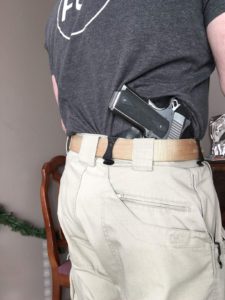
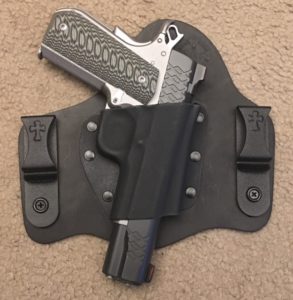
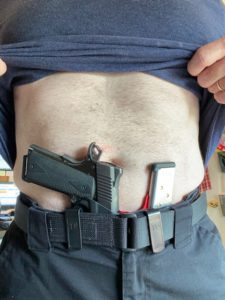

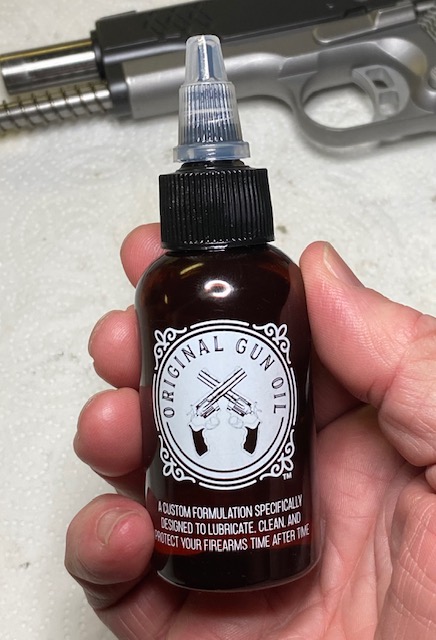


Hybrid holsters are bad.
Letting several inches of the barrel pop out of the holster is bad.
Thanks for the comment! Opinions vary on holsters and holster construction, just as opinions vary on which caliber is best. A holster needs to hold you firearm securely and completely cover the trigger and trigger guard to be a “good” holster. As long as these criteria are met, the barrel being exposed below the holster is of little consequence. Thanks for checking out the article!
Dave
Great Article ..The Belly Band is another option but doesnt 100% bring with it the rididgy of kydex cover . It does cover the fully cover the guard and trigger but isnt the easiest to re-holster once drawn ..Ive got a good IWB on order but until then I am relegated to the nylon due to lighting system on the frame . Great article and thanks for sharing your experience
Raymond,
Thanks for the comment! I have used belly bands in the past but much prefer the security of Kydex!
Dave